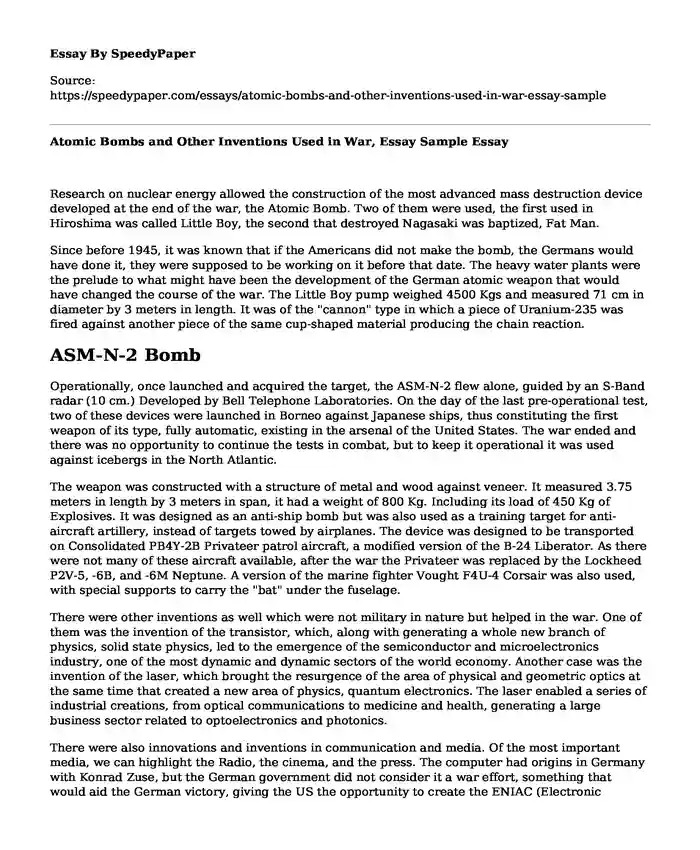
| Type of paper: | Essay |
| Categories: | World War 2 Physics Army |
| Pages: | 3 |
| Wordcount: | 722 words |
Research on nuclear energy allowed the construction of the most advanced mass destruction device developed at the end of the war, the Atomic Bomb. Two of them were used, the first used in Hiroshima was called Little Boy, the second that destroyed Nagasaki was baptized, Fat Man.
Since before 1945, it was known that if the Americans did not make the bomb, the Germans would have done it, they were supposed to be working on it before that date. The heavy water plants were the prelude to what might have been the development of the German atomic weapon that would have changed the course of the war. The Little Boy pump weighed 4500 Kgs and measured 71 cm in diameter by 3 meters in length. It was of the "cannon" type in which a piece of Uranium-235 was fired against another piece of the same cup-shaped material producing the chain reaction.
ASM-N-2 Bomb
Operationally, once launched and acquired the target, the ASM-N-2 flew alone, guided by an S-Band radar (10 cm.) Developed by Bell Telephone Laboratories. On the day of the last pre-operational test, two of these devices were launched in Borneo against Japanese ships, thus constituting the first weapon of its type, fully automatic, existing in the arsenal of the United States. The war ended and there was no opportunity to continue the tests in combat, but to keep it operational it was used against icebergs in the North Atlantic.
The weapon was constructed with a structure of metal and wood against veneer. It measured 3.75 meters in length by 3 meters in span, it had a weight of 800 Kg. Including its load of 450 Kg of Explosives. It was designed as an anti-ship bomb but was also used as a training target for anti-aircraft artillery, instead of targets towed by airplanes. The device was designed to be transported on Consolidated PB4Y-2B Privateer patrol aircraft, a modified version of the B-24 Liberator. As there were not many of these aircraft available, after the war the Privateer was replaced by the Lockheed P2V-5, -6B, and -6M Neptune. A version of the marine fighter Vought F4U-4 Corsair was also used, with special supports to carry the "bat" under the fuselage.
There were other inventions as well which were not military in nature but helped in the war. One of them was the invention of the transistor, which, along with generating a whole new branch of physics, solid state physics, led to the emergence of the semiconductor and microelectronics industry, one of the most dynamic and dynamic sectors of the world economy. Another case was the invention of the laser, which brought the resurgence of the area of physical and geometric optics at the same time that created a new area of physics, quantum electronics. The laser enabled a series of industrial creations, from optical communications to medicine and health, generating a large business sector related to optoelectronics and photonics.
There were also innovations and inventions in communication and media. Of the most important media, we can highlight the Radio, the cinema, and the press. The computer had origins in Germany with Konrad Zuse, but the German government did not consider it a war effort, something that would aid the German victory, giving the US the opportunity to create the ENIAC (Electronic Numeric Integrator and Calculator) which helped them win the war. The Allies developed the radar (Radio Detection and Ranging) which was used to measure the distances, directions, and speeds of ships, aircraft and motor vehicles through electromagnetic waves. In addition to the use of ASDIC or Sonar (sound navigation and Racing) consisting of a sound navigation technique, used to communicate, and detect underwater objects.
Although the Axis (especially Germany) produced more revolutionary prototypes and weapons, the truth is that the Allied models proved to be of more immediate application and, in the long run, ensured the final victory of the allies (together with other factors, obviously), thus achieving the Allies a slight final advantage in the technological race between both sides, an advantage that was decisive for the final victory.
Bibliography
Kennedy, Paul M. n.d. Engineers of Victory. America: Random House Trade Paperbacks, 2013.
Septimus H. Paul. Nuclear Rivals: Anglo-American Atomic Relations, 1941-1952. Ohio State U.P. (2000): pp. 1-5.
Steve, Zaloga. Armored champion: the top tanks of World War II. Stackpole Books, 2015.
Cite this page
Atomic Bombs and Other Inventions Used in War, Essay Sample. (2022, Jun 07). Retrieved from https://speedypaper.net/essays/atomic-bombs-and-other-inventions-used-in-war-essay-sample
Request Removal
If you are the original author of this essay and no longer wish to have it published on the SpeedyPaper website, please click below to request its removal:
- Humanitarian War Essay Sample
- Application Letter Example for Pre-doctoral Internship Training Program
- Free Essay on Problem-Solving Techniques
- Everyday Use by Alice Walker, Literary Essay Example
- Free Essay Sample on Software Maturity Model
- Essay Example on Muslim Brotherhood Organization
- Essay Example. Man of Destiny in the Play "Oedipus the King"
Popular categories




